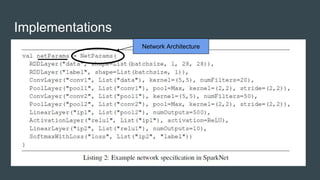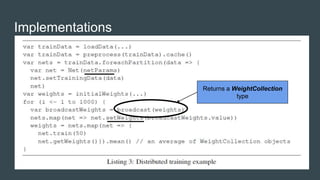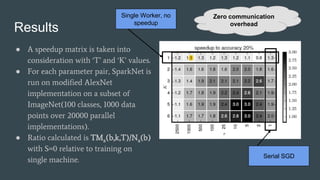SparkNet presentation
- 1. SparkNet: Training Deep Networks in Spark Authors: Philipp Moritz, Robert Nishihara, Ion Stoica, Michael I. Jordan (EECS, University of California, Berkeley) Paper Presentation By: Sneh Pahilwani (T-13) (CISE, University of Florida, Gainesville)
- 2. Motivation ● Much research in making deep learning models more accurate. ● With deeper models, comes better performance responsibility. ● Existing frameworks cannot handle asynchronous and communication-intensive workloads. ● Claim: SparkNet implements a scalable, distributed algorithm for training deep networks that can be applied to existing batch-processing frameworks like MapReduce and Spark, with minimal hardware requirements.
- 3. SparkNet Features ● Provides a convenient interface to be able to access Spark RDDs. ● Provides Scala interface to call Caffe. ● Has a lightweight multi-dimensional tensor library. ● SparkNet can scale well to the cluster size and can tolerate a high communication delay. ● Easy to deploy and no parameter adjustment. ● Compatible with existing Caffe models.
- 4. Parameter Server Model ● One or more master nodes hold the latest model parameters in memory and serve them to worker nodes upon request. ● The nodes then compute gradients with respect to these parameters on a minibatch drawn from the local dataset copy. ● These gradients are sent back to the server, which updates the model parameters. SparkNet architecture
- 5. Implementations ● SparkNet is built on top of Apache Spark and Caffe deep learning library. ● Uses Java to access the Caffe data. ● Uses Scala to access the parameters of the Caffe. ● Uses ScalaBuff to make the Caffe network to maintain a dynamic structure at run time. ● SparkNet can be compatible with some of the Caffe model definition files, and supports the Caffe model parameters of the load.
- 6. Implementations Map from layer names to weights Lightweight multi-dimensional tensor library implementation.
- 9. Stochastic Gradient Descent Comparison ● Conventional: ○ A conventional approach to parallelize gradient computation requires a lot of broadcasting and communication overhead between the workers and parameter server after every Stochastic Gradient Descent(SGD) iteration. ● SparkNet: ○ In this model, a fixed parameter is set for every worker in the Spark cluster (number of iterations or time limit), after which the params are sent to the master and averaged.
- 10. SGD Parallelism ● Spark consists of a single master node and a number of worker nodes. ● The data is split among the Spark workers. ● In every iteration, the Spark master broadcasts the model parameters to each worker. ● Each worker then runs SGD on the model with its subset of data for a fixed number of iterations (say, 50), after which the resulting model parameters on each worker are sent to the master and averaged to form the new model parameters.
- 11. Naive Parallelization Number of serial iterations
- 12. Practical Limitations of Naive Parallelization ● Naive parallelization would distribute minibatch ‘b’ over ‘K’ machines, computing gradients separately and aggregating results on one node. ● Cost of computation on single node in single iteration: C(b/K) and satisfies C(b/K) >= C(b)/K. Hence, total running time to achieve test accuracy ‘a’: Na(b)C(b)/K (in theory) ● Limitation #1: For approximation, C(b)/K ~ C(b/K) to hold, K<<b , limits number of machines in cluster for effective parallelization. ● Limitation #2: To overcome above limitation, minibatch size could be increased but does not decrease Na(b) enough to justify the increment.
- 13. SparkNet ParallelizationNumber of iterations on every machine Number of rounds
- 14. SparkNet parallelization ● Proceeds in rounds, where for each round, each machine runs SGD for ‘T’ iterations with batch size ‘b’. ● Between rounds, params on workers are gathered on master, averaged and broadcasted to workers. ● Basically, synchronization happens every ‘T’ iterations. ● Total number of iterations: TMa(b,k,T). ● Total time taken: (TC(b) + S)Ma(b,k,T).
- 15. Results ● A speedup matrix is taken into consideration with ‘T’ and ‘K’ values. ● For each parameter pair, SparkNet is run on modified AlexNet implementation on a subset of ImageNet(100 classes, 1000 data points over 20000 parallel implementations). ● Ratio calculated is TMa(b,k,T)/Na(b) with S=0 relative to training on single machine. Serial SGD Single Worker, no speedup Zero communication overhead
- 16. Results Speedup measured as a function of communication overhead ‘S’. (5-node cluster) Non-Zero communication overhead
- 17. Training Benchmarks ● AlexNet on ImageNet training. ● T = 50. ● Single GPU nodes. ● Accuracy measured: 45% ● Time measured: ○ Caffe: 55.6 hours (baseline) ○ SparkNet 3: 22.9 hours (2.4) ○ SparkNet 5: 14.5 hours (3.8) ○ SparkNet 10: 12.8 hours (4.4)
- 18. Training Benchmarks ● GoogLeNet on ImageNet training. ● T = 50. ● Multi-GPU nodes. ● Accuracy measured: 40% ● Speedup measured (compared to Caffe 4-GPU): ○ SparkNet 3-node 4-GPU: 2.7 ○ SparkNet 6-node 4-GPU: 3.2 ● On top of Caffe 4-GPU speedup of 3.5.
- 19. THANK YOU!



















